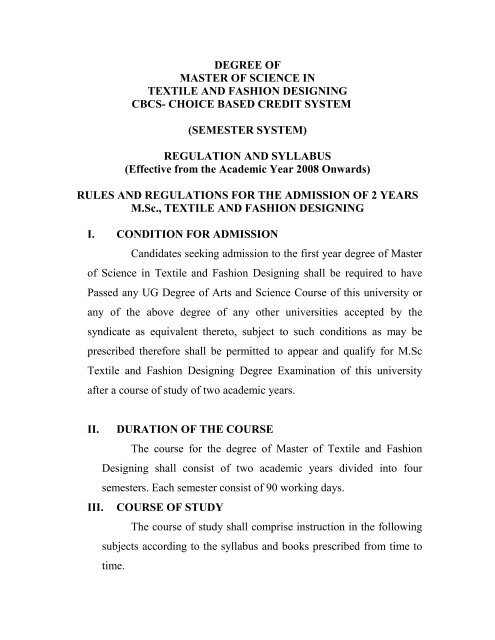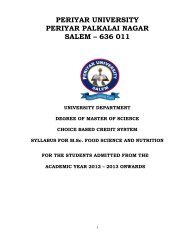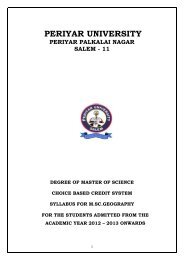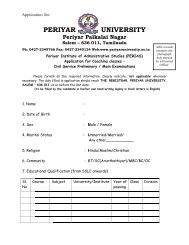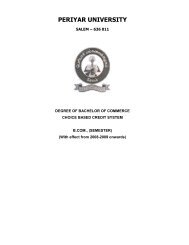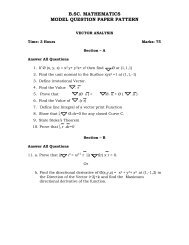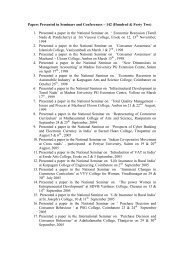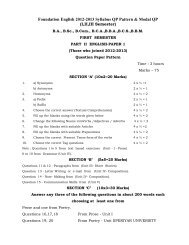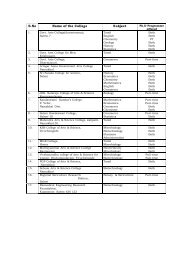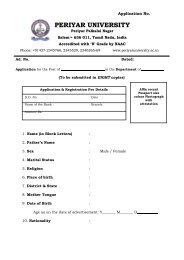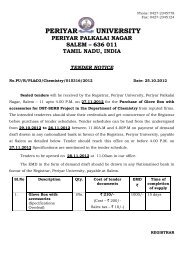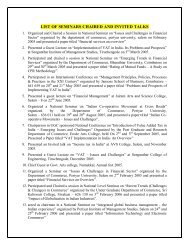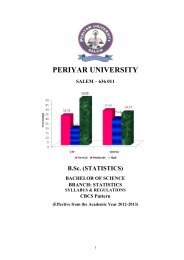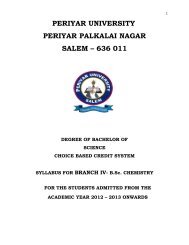M.Sc. Textile and Fashion Designing - Periyar University
M.Sc. Textile and Fashion Designing - Periyar University
M.Sc. Textile and Fashion Designing - Periyar University
Create successful ePaper yourself
Turn your PDF publications into a flip-book with our unique Google optimized e-Paper software.
DEGREE OF<br />
MASTER OF SCIENCE IN<br />
TEXTILE AND FASHION DESIGNING<br />
CBCS- CHOICE BASED CREDIT SYSTEM<br />
(SEMESTER SYSTEM)<br />
REGULATION AND SYLLABUS<br />
(Effective from the Academic Year 2008 Onwards)<br />
RULES AND REGULATIONS FOR THE ADMISSION OF 2 YEARS<br />
M.<strong>Sc</strong>., TEXTILE AND FASHION DESIGNING<br />
I. CONDITION FOR ADMISSION<br />
C<strong>and</strong>idates seeking admission to the first year degree of Master<br />
of <strong>Sc</strong>ience in <strong>Textile</strong> <strong>and</strong> <strong>Fashion</strong> <strong>Designing</strong> shall be required to have<br />
Passed any UG Degree of Arts <strong>and</strong> <strong>Sc</strong>ience Course of this university or<br />
any of the above degree of any other universities accepted by the<br />
syndicate as equivalent thereto, subject to such conditions as may be<br />
prescribed therefore shall be permitted to appear <strong>and</strong> qualify for M.<strong>Sc</strong><br />
<strong>Textile</strong> <strong>and</strong> <strong>Fashion</strong> <strong>Designing</strong> Degree Examination of this university<br />
after a course of study of two academic years.<br />
II. DURATION OF THE COURSE<br />
The course for the degree of Master of <strong>Textile</strong> <strong>and</strong> <strong>Fashion</strong><br />
<strong>Designing</strong> shall consist of two academic years divided into four<br />
semesters. Each semester consist of 90 working days.<br />
III. COURSE OF STUDY<br />
The course of study shall comprise instruction in the following<br />
subjects according to the syllabus <strong>and</strong> books prescribed from time to<br />
time.
SEM<br />
I<br />
II<br />
IV. EXAMINATIONS<br />
The theory examinations will be conducted for 3 Hours by the<br />
university in the subjects prescribed for all the semesters in the month<br />
of November & April every year.<br />
The practical examinations will be conducted for 4 Hours by<br />
the university in all the subjects prescribed in the month of November<br />
& April.<br />
At the end of the fourth semester project viva-voce will be<br />
conducted on the basis of the Dissertation/Project Report submitted by<br />
the student. The Viva-voce will be conducted by one Internal <strong>and</strong> One<br />
External Examiners.<br />
V. SCHEME OF THE EXAMINATION<br />
The scheme of examinations for the course is given in<br />
Annexure. All the practical examinations/ Project work shall be<br />
conducted & evaluated internally by the institution themselves with<br />
internal <strong>and</strong> external examiners appointed by the university.<br />
COURSE<br />
HRS<br />
MARKS<br />
COURSE<br />
CREDIT<br />
CODE<br />
L T/P CIA EA TOTAL<br />
08PTF01 Core I 4 2 5 25 75 100<br />
08PTF02 Core II 4 2 5 25 75 100<br />
08PTFP01 Core Practical I - 6 4 40 60 100<br />
08PTFP02 Core Practical II - 6 4 40 60 100<br />
08PTFZP01 Elective Practical I - 6 5 25 75 100<br />
30 23<br />
08PTF03 Core III 4 2 5 25 75 100<br />
08PTF04 Core IV 4 2 4 25 75 100<br />
08PTFZP02 Elective Practical II - 6 4 40 60 100<br />
08PTFP03 Core Practical III - 6 4 40 60 100
III<br />
IV<br />
08PBAED01 EDC 2 2 4 25 75 100<br />
08PHR01 Human Rights 1 1 2 25 75 100<br />
30 23<br />
08PTFP04 Core Practical IV - 6 4 40 60 100<br />
08PTF05 Core V 6 - 4 25 75 100<br />
08PTF06 Core VI 6 - 5 25 75 100<br />
08PTFP05 Core Practical V - 6 4 40 60 100<br />
08PTFZ01 Elective I 6 - 4 25 75 100<br />
30 21<br />
08PTF07 Core VII 6 - 5 25 75 100<br />
08PTF08 Core VIII 6 - 5 25 75 100<br />
08PTFP06 Core Practical VI - 6 4 40 60 100<br />
08PTFZ02 Elective IV 6 - 4 25 75 100<br />
08PTFP07 Project Viva Voce 6 - 5 - 100 100<br />
30 23<br />
TOTAL 90<br />
VI.DISSERTATION<br />
(a)TOPIC<br />
The topic of the dissertation shall be assigned to the<br />
c<strong>and</strong>idate before the end of the second semester.<br />
No. OF COPIES/DISTRIBUTION OF DISSERTATION<br />
The students should prepare three copies of thesis <strong>and</strong><br />
submit the same for the evaluation by examiners. After evaluation one<br />
copy is to be retained in the college library <strong>and</strong> one copy is to be<br />
submitted to the university (Registrar) <strong>and</strong> one copy can be held by<br />
the student.
(a) FORMAT TO BE FOLLOWED<br />
The formats/certificates for thesis to be submitted by the<br />
students are given below:<br />
FORMAT FOR THE PREPARATION OF PROJECT WORK<br />
(a) Title page<br />
(b) Bonafide certificate<br />
(c) Acknowledgement<br />
(d) Table of contents<br />
CONTENTS<br />
CHAPTER NO. TITLE PAGE NO.<br />
1. INTRODUCTION<br />
2. REVIEW OF LITERATURE<br />
3. EXPERIMENTAL PROCEDURE<br />
4. RESULTS AND DISCUSSION<br />
5. SUMMARY AND CONCLUSION<br />
6. BIOLIOGRAPHY<br />
7. APPENDIX
Format of the title page<br />
TITLE OF THE DISSERTATION<br />
Dissertation submitted in part fulfillment of the requirement for the Degree<br />
of Master Of <strong>Sc</strong>ience In<br />
TEXTILE AND FASHION DESIGNING<br />
<strong>Periyar</strong> <strong>University</strong>, Salem-636011<br />
By<br />
Student name:<br />
Register number:<br />
college/university/department<br />
Year:<br />
Format of the certificate:<br />
This is to certify that the dissertation entitled…………………...<br />
…………………………submitted in part fulfillment of the requirement of<br />
the degree of Master of science in textile <strong>and</strong> fashion designing to the<br />
<strong>Periyar</strong> university, Salem is a record of bonafide research work carried out<br />
by …………………….. under my supervision <strong>and</strong> guidance <strong>and</strong> that no part<br />
of the dissertation, has been submitted for the award of any degree, diploma,<br />
fellowship or other similar titles or prizes <strong>and</strong> that the work has not been<br />
published in part of full in any scientific or popular journals or magazines.<br />
Date:<br />
Place:<br />
Signature of the Guide<br />
Signature of the HOD<br />
Internal Examiner<br />
External Examiner
Guidelines for the approval for PG guides for guiding students in their<br />
research for submitting dissertation:<br />
A person seeking for recognition as guide should have<br />
PhD degree\ M.Phil degree\ M.<strong>Sc</strong> degree with two years experience\<br />
M.Tech Degree<br />
VI. PASSING RULES<br />
• Theory Subjects<br />
75% of the marks for external evaluation <strong>and</strong> 25% marks are<br />
allotted for internal evaluation.<br />
C<strong>and</strong>idate is dem<strong>and</strong> to have passed to a subject, if he/she get a<br />
minimum of 50% of total marks in theory subjects with internal mark<br />
of 12 marks <strong>and</strong> external mark of 38 marks.<br />
• Practical/Project<br />
60% of the marks for external evaluation <strong>and</strong> 40% marks are<br />
allotted for internal evaluation.<br />
For practical subjects, the c<strong>and</strong>idate should get minimum marks<br />
of 30 marks in external evaluation out of 60 <strong>and</strong> 20 marks in internal<br />
evaluation out of 40.<br />
For project work <strong>and</strong> viva voce a c<strong>and</strong>idate should get<br />
minimum of 50 marks out of 100.<br />
VII. CLASSIFICATION OF SUCCESSFUL CANDIDATES<br />
C<strong>and</strong>idates who secure not less than 60% of the aggregate<br />
marks in the whole examination shall be declared to have passed the<br />
examination in first class.
All other c<strong>and</strong>idates shall be declared to have passed in the<br />
second class.<br />
C<strong>and</strong>idates who obtain 75% of the marks in aggregate shall be<br />
deemed to have passed the examination in first class with distinction<br />
provided they pass all the examinations prescribed for the course at<br />
the first appearance.<br />
C<strong>and</strong>idates who pass all the examinations prescribed for the<br />
course in the first instance <strong>and</strong> with in the period of two academic<br />
years from the year of admission of the course only are eligible for<br />
university ranking.<br />
VIII. QUESTION PAPER PATTERN<br />
(a) Theory:<br />
Time: 3 Hours<br />
Total Marks: 75 Marks<br />
PART A (5 X5 = 25)<br />
Either or Choice<br />
ANSWER ALL THE QUESTIONS<br />
PART B (5 X10 = 50)<br />
ANSWER ALL QUESTIONS<br />
Either or Choice
INTERNAL ASSESSMENT<br />
MARKS<br />
SEMINAR : 5<br />
TEST : 10<br />
ASSIGNMENT : 5<br />
ATTENDANCE : 5<br />
25<br />
PASSING MINIMUM (IA) 50%<br />
PASSING MINIMUM (UE) 50%<br />
PASSING MINIMUM TOTAL<br />
- 12 MARKS<br />
- 38 MARKS<br />
────────<br />
- 50 MARKS<br />
────────<br />
(b) Practical:<br />
Time: 4 Hours<br />
Total Marks: 60 Marks<br />
PART A (1 X20= 20)<br />
Either or Choice<br />
ANSWER ANY ONE<br />
PART B (1 X40 = 40)<br />
Either or Choice<br />
ANSWER ANY ONE<br />
PASSING MINIMUM (IA) 50%<br />
PASSING MINIMUM (UE) 50%<br />
PASSING MINIMUM TOTAL<br />
NO CLASSIFICATION OF INTERNAL MARKS<br />
- 20 MARKS<br />
- 30 MARKS<br />
- 50 MARKS
IX. MAXIMUM DURATION FOR THE COMPLETION OF THE<br />
PG PROGRAMME<br />
The maximum duration for the completion of the PG<br />
programme shall not exceed eight semesters.<br />
X. COMMENCEMENT OF THIS REGULATION<br />
These regulations shall take effect from the academic year 2008<br />
onwards i.e., for the students who are admitted to the first year of the<br />
course during the academic year 2008 – 2009 thereafter.
MSC TEXTILE AND FASHION DESIGN<br />
CHOICE BASED CREDIT SYSTEM<br />
08PTF01 TEXTILE SCIENCE<br />
UNIT - I<br />
<strong>Textile</strong> Fibers – Definition, Classification, Manufacturing, Physical & Chemical<br />
Properties of natural fibres – Cotton, Linen, Wool, Silk <strong>and</strong> Jute. Man made fibres –<br />
Polyester, Nylon, Acrylic, Sp<strong>and</strong>ex / Lycra, Viscose Rayon& Tencel.<br />
UNIT - II<br />
Sequence of spinning processes – objective <strong>and</strong> working principles of Blow room,<br />
Carding, Draw frame <strong>and</strong> Comber.<br />
UNIT - III<br />
Objects <strong>and</strong> working Principles of Simplex & Spinning (Ring frame).<br />
Yarn – Definition, Classification.<br />
UNIT – IV<br />
Weaving processes – Warp winding, Warping, Sizing <strong>and</strong> Pirn winding.<br />
Primary <strong>and</strong> Secondary & Auxiliary motions of power loom.<br />
UNIT - V<br />
Shuttle-less loom - working Principles of Air jet, Water jet, Projectile <strong>and</strong> Rapier<br />
loom.<br />
REFERENCES<br />
<strong>Textile</strong> <strong>Sc</strong>ience, E.P.G. Gohl <strong>and</strong> L.D. vilensky, 2 nd Ed., CB, Publishers, New<br />
Delhi.<br />
Technology of spinning, W.D. Klein , <strong>Textile</strong> Institute, Manchester.<br />
Principles of weaving, Mark <strong>and</strong> Robinson, <strong>Textile</strong> institute Manchester.<br />
<strong>Textile</strong>s fiber to fabric, corbman B.P, International Edn, 1983.<br />
Mechanism of Weaving, N.N. Banner.J.I Vol – I & II <strong>Textile</strong> Institute.
08PTF02 WORLD COSTUME AND TEXTILES<br />
UNIT - I<br />
Costumes of European countries – Egypt, Greece, Roman, Sweden, Germany,<br />
Pol<strong>and</strong>.<br />
UNIT - II<br />
Costumes of Far Eastern Countries – Japan, Hong Kong , Korea, Srilanka,<br />
Pakistan, Malaysia, China, Burma, Thail<strong>and</strong> & Philippines.<br />
UNIT - III<br />
Costumes of Africa –North, West, South & East<br />
UNIT - IV<br />
American Costumes – North <strong>and</strong> central America – men, & women costumes of<br />
difference states of America.<br />
UNIT -V<br />
Study of the following women textiles with emphasis to fabric texture, design,<br />
colour & weaving techniques – Dacca muslin, JamDhani, Ch<strong>and</strong>eri, Brocades, Baluchar,<br />
Himrus & Amrus & Kashmir shawls<br />
a. Woven<br />
b. Dyed<br />
c. Embroidery<br />
d. Printed fabrics.<br />
Famous embroideries of India & world.<br />
REFERENCES<br />
Costumes of India <strong>and</strong> Pakistan, Das S.N, DB Taraporevala sons & Co,<br />
Mumbai 1958.<br />
Costumes through the ages lever, Jamession <strong>and</strong> <strong>Sc</strong>huster, Newyork, 1968.<br />
Traditional Indian textiles, Gillow or Barnard, Thames <strong>and</strong> Hudson, London,<br />
1994.<br />
History of <strong>Fashion</strong>, Anderson Black J, orbis publishing Ltd, USA 1985.<br />
Costumes & textiles of Royal India, Ritukumar, Christies Book Ltd, London<br />
1999.
08PTFP01 TEXTILE SCIENCE PRACTICAL<br />
1. Identification of <strong>Textile</strong> fibres by<br />
a) Microscopical Test<br />
b) Solubility Test<br />
c) Burning Test<br />
2. Analysis of blend ratio of yarn<br />
3. Analysis of fabric for design, draft, peg plan, threads / inch, yarn count ,<br />
crimp, cover factor <strong>and</strong> weight per square yard of warp, weft <strong>and</strong> fabric.<br />
a) Plain <strong>and</strong> its derivatives<br />
b) Twill <strong>and</strong> its derivatives<br />
c) Satin of Sateen derivatives<br />
d) Honey comb<br />
e) Huck – a – back.<br />
f) Dobby weaves<br />
h) Jacquard Weave<br />
08PTFP02 FASHION SKETCHING PRACTICAL<br />
1. Sketch different types of colour theory<br />
2. Creating design <strong>and</strong> its application on garments.<br />
3. Sketching of different action croques.<br />
4. Fabric Painting.<br />
5. Silk Painting<br />
6. Glass painting<br />
7. Wardrobe Collection for Teenage boys <strong>and</strong> girls.<br />
8. Lay figure - 7 ½ head<br />
9. <strong>Fashion</strong> figures – 8,10,12 head<br />
10. Stick <strong>and</strong> Block figures.
08PTFZP01 ADVANCED GARMENT CONSTRUCTION<br />
1. <strong>Designing</strong> <strong>and</strong> constructing Children’s garment of current trend – any 3 styles.<br />
2. <strong>Designing</strong> <strong>and</strong> constructing Women’s garment of current trend – any 3 styles.<br />
3. <strong>Designing</strong> <strong>and</strong> constructing Men’s garment of current trend – any 3 styles.<br />
4. <strong>Designing</strong> <strong>and</strong> constructing garment for a French / American Style.<br />
5. <strong>Fashion</strong> show production with the theme.<br />
08PTF03 TEXTILE CHEMISTRY<br />
UNIT I<br />
Introduction – process sequence- singeing, shearing, desizing, scouring, bleaching<br />
<strong>and</strong> mercerizing – objectives, types, process parameters, operations <strong>and</strong> machines.<br />
Evaluation of fabrics- absorbency, whiteness, chemical change <strong>and</strong> degradation.<br />
UNIT II<br />
Dyeing – theory of dyeing- classification of colorants – fastness properties of<br />
dyes- direct, reactive, vat, sulphur, azoic, acid, basic, disperse <strong>and</strong> natural dyesproperties<br />
<strong>and</strong> application on suitable material.<br />
UNIT III<br />
Printing – ingredients – styles of printing – direct, discharge <strong>and</strong> resist. Stencil,<br />
block, flock, batik, transfer, foam, screen, capsule printing <strong>and</strong> tie- dye printing.<br />
UNIT IV<br />
Dyeing machines – fibre, yarn, hank <strong>and</strong> package. Fabric – Jipper, winch, soft<br />
flow, HPHT, jet, continuous dyeing <strong>and</strong> garment dyeing machines.<br />
Dyeing defects, causes <strong>and</strong> remedies.<br />
Printing machines- roller, flat bed, rotary screen <strong>and</strong> garment printing. Printing<br />
defects, causes <strong>and</strong> remedies<br />
UNIT V<br />
Pollution – types- l<strong>and</strong>, water, air noise – causes <strong>and</strong> remedies.<br />
Effluent treatment – methods – colour removal – bio degradation.<br />
Eco friendly textiles.
REFERENCES<br />
Technology of textile processing – Volume I, II,III,IV,V, VI, VIII, IX,<br />
& X- Dr. V.A Shennai.<br />
Dyeing <strong>and</strong> chemical technology of textile fibers – E.R.Trotman.<br />
Technology of textile printing – Prayag. R.S.<br />
Pollution in textile industry K.B. Krishnakumar, SSM ITT Staff <strong>and</strong><br />
students co-operative stores.<br />
Treatment of textile processing effluents – Saking publications,<br />
Coimbatore.<br />
08PTF04 RESEARCH METHODOLOGY AND STATISTICS<br />
UNIT I<br />
Research- definition <strong>and</strong> scope, types of research- historical survey, experimental<br />
<strong>and</strong> case study, definition <strong>and</strong> identification of a research problem. Basic principle of<br />
research designing.<br />
UNIT II<br />
Meaning <strong>and</strong> scope of statistics. Role of statistics in research, measures of central<br />
tendency <strong>and</strong> description, skew ness <strong>and</strong> kurtosis, probability- definition, concept of<br />
discrete probability distribution, normal distribution –use of normal probability tables.<br />
UNIT III<br />
Elements of testing of a statistical hypothesis, formulation of the problem<br />
Definition of type I <strong>and</strong> II errors. Levels of significance large sample test for proportions.<br />
Difference in proportions for means <strong>and</strong> difference in means.<br />
UNIT IV<br />
Application of students P-test for small samples for single mean, difference in<br />
means- test for equality of variance.<br />
Correlation, coefficient of correlation <strong>and</strong> its interpretation, rank correlation,<br />
regression equation <strong>and</strong> predictions.<br />
Non- parametric test, application of chi- square test.
UNIT V<br />
Data gathering instrument- questionnaire, interview, observation, scaling methods<br />
reliability <strong>and</strong> validity of measuring instruments sampling – types of samples, selection<br />
of samples, benefits of sampling, evaluating a sample.<br />
Analysis of the data- categorization, coding, tabulation <strong>and</strong> statistical testing.<br />
Presentation <strong>and</strong> interpretation of test data.<br />
Conclusion <strong>and</strong> recommendations. Report writing.<br />
REFERENCES<br />
Gupta S.P. Statistical methods. Sultan ch<strong>and</strong> & Co, New Delhi 1994.<br />
Snedocor G.W. <strong>and</strong> Cochram W.G. Statistical methods, Oxford <strong>and</strong> IBH<br />
1967.<br />
Bert J.W. Research in education. Prentice hall. New Delhi 1983.<br />
Philyis B.S, Social research strategy <strong>and</strong> tactics. Macmillian, 1977.<br />
Young. P.V <strong>and</strong> Sehmid C.F. scientific social survey <strong>and</strong> research,<br />
Prentice hall, New Delhi 1968.<br />
08PTFP03 TEXTILE CHEMISTRY PRACTICAL<br />
1. Desizing of cotton<br />
2. <strong>Sc</strong>ouring of cotton<br />
3. Bleaching of cotton<br />
4. Cotton Dyeing –Direct dye, Reactive Dye,Vat Dye, Sulphur Dye& Napthol dyes .<br />
5. Silk <strong>and</strong> wool Dyeing – Acid Dye , Basic Dye.<br />
6. Polyester Dyeing – Disperse Dye<br />
7. Tie & Dye Technique – Sun Pattern Marbling & Pleating<br />
8. Printing – Direct, Discharge & Resist Style
08PTFZP02 DRAPING PRACTICAL<br />
The following samples using the Draping Technique<br />
1. Create any one of the garment for a girl child.<br />
2. Create any one of the garment for a boy child.<br />
3. Create any one of the garment for a Teenage girl.<br />
4. Create any one of the garment for a Teenage boy.<br />
5. Dart Manipulation.<br />
6. Pleats, Darts, tucks & Gathers.<br />
7. Basic Waist.<br />
8. Neck line, Armhole, waistline <strong>and</strong> Yokes variations.<br />
9. Collars <strong>and</strong> Sleeves any one variation.<br />
10. Skirts any one variation.<br />
08PTFP04 CAD IN FASHION AND APPAREL PRACTICAL<br />
1. COREL DRAW<br />
Creating pattern <strong>and</strong> design sample for children’s wear using Corel Draw.<br />
Creating Pattern <strong>and</strong> design samples for women’s wear using Corel Draw.<br />
Creating Pattern <strong>and</strong> design sample for men’s wear using Corel Draw.<br />
2. ADOBE PHOTOSHOP<br />
Various tools <strong>and</strong> operations for Drawing <strong>and</strong> designing with.<br />
Creating Designs<br />
Application of Colors<br />
Importing the Silhouette illustrations from Adobe illustrator.<br />
Application of garment <strong>and</strong> textile design.<br />
3. COMPUTER AIDED GARMENT DESIGNING<br />
Tools <strong>and</strong> Techniques<br />
Sketching different types of garments.<br />
Pattern creation of Children’s, women’s <strong>and</strong> men’s garments.<br />
Pattern grading for Children’s, women’s <strong>and</strong> men’s garments.
Marker efficiency<br />
Lay Planning<br />
<strong>Fashion</strong> Studio – Utility <strong>and</strong> tools.<br />
Children’s, women’s <strong>and</strong> men’s garments.<br />
08PTF05 CARE FOR TEXTILE & CLOTHING<br />
UNIT - I<br />
Water- types- soft water-hard water- purification of water. Soaps–types–<br />
manufacturing – properties. Detergents–types -properties.<br />
UNIT-II<br />
Laundering – objects – methods - laundering of white - coloured, cotton, silk, wool,<br />
synthetic fabrics, lace materials, carpets. Clothing storing- mending - darning- seasonal<br />
care.<br />
UNIT-III<br />
Dry cleaning - chemicals used - sequence - method - commercial dry cleaning.<br />
Washing machines – types - working principles.<br />
UNIT-IV<br />
Ironing <strong>and</strong> pressing - hot air, steam, permanent pressing, thumble drier –hydro<br />
extractor - working principle.<br />
UNIT-V<br />
Stain - classification – removal of known <strong>and</strong> unknown stains - rules in removing<br />
fresh <strong>and</strong> old stains. Stain removers - grease solvents – absorbents - washing soda -<br />
borax.<br />
Care labels – importance- symbols - uses.<br />
REFERENCES<br />
Fabric care- Noemia. D’Souza.<br />
Fundamentals of textiles <strong>and</strong> their care- Susheela.D<br />
House hold textiles <strong>and</strong> laundry work- Durga.D<br />
<strong>Textile</strong>s fiber to fabric- Bernard.P.Carbman, MC Graw gill international Edition.
08PTF06 TEXTILE TESTING<br />
UNIT I<br />
General aspects of textile testing <strong>and</strong> quality control – Moisture <strong>and</strong> its relations to<br />
textile materials. Moisture content, moisture regain <strong>and</strong> relative humidity.<br />
Fibre testing – fibre length, fineness, maturity, strength <strong>and</strong> trash for natural <strong>and</strong><br />
manmade fibers <strong>and</strong> blends. Brief study of HVI <strong>and</strong> AFIS.<br />
UNIT II<br />
Yarn Testing – yearn numbering – simple calculations, yarn strength, twist, <strong>and</strong><br />
evenness, neps, crimp, hairiness <strong>and</strong> yarn appearance. Aspects of Uster evenness tester.<br />
UNIT III<br />
Fabric testing – fabric particulars – length, width, crimp, threads / inch, thread<br />
count, weight. Fabric strength – tensile, tearing & bursting. Abrasion resistance, pilling<br />
resistance, crease recovery, stiffness, drapability, air permeability <strong>and</strong> water permeability.<br />
Brief study of Kawabata System & KES<br />
UNIT IV<br />
Colour fastness in textiles – washing, light rubbing, perspiration bleaching <strong>and</strong> dry<br />
cleaning. Colour matching cabinets shade matching.<br />
UNIT V<br />
Routine tests performed in the textile industries- st<strong>and</strong>ards <strong>and</strong> specification used<br />
in textile industries – control chart concepts, control limits. Types of Chart - X <strong>and</strong> R<br />
Chart.<br />
REFERENCES<br />
Principles of <strong>Textile</strong> Testing, Booth J E, Hoy Books, London (1970)<br />
Technology of textile properties Marjorie A Taylor, Forbes Publication Ltd,<br />
London (1972).<br />
<strong>Textile</strong> Testing, Angappan P <strong>and</strong> Gopalakrishnan R, SSM Institute of<br />
<strong>Textile</strong> Technology, Komara Palayam.<br />
Fiber <strong>Sc</strong>ience, Mishra S P <strong>and</strong> Kesavan B K, SSM Institute of textile<br />
technology, Komarapalayam.<br />
Objective evaluation of fabrics, Styios G, John Wiley & Sons USA.
08PTFP05 TEXTILE TESTING PRACTICAL<br />
1. Determination of yarn count<br />
2. Determination of yarn twist<br />
3. Determination of yarn strength<br />
4. Determination of Tensile Strength of the given Fabric.<br />
5. Determination of Bursting Strength of the given Fabric.<br />
6. Determination of tearing strength of a fabric<br />
7. Determination of Stiffness of the given Fabric.<br />
8. Determination of Abrasion Resistance of the given Fabric.<br />
9. Determination of Crease recovery of the given Fabric.<br />
10. Determination of Drape of the given Fabric.<br />
11. Determination of Color Fastness to light, washing, rubbing & perspiration<br />
12. Determination of Shrinkage of the given Fabric.<br />
08PTF07 TEXTILE FINISHING<br />
UNIT-I<br />
Finishing-objects – types – classification - mechanical finish - zero zero<br />
(Sanforising) - compacting - calendaring – heat setting - brushing –chemical finishing –<br />
softening – stiffening - resin finish - silicone finish.<br />
UNIT-II<br />
Special finishes - water repellent - water proof - flame proof - fire retardant –<br />
antimicrobial - anti bacterial - anti mildew.<br />
UNIT-III<br />
Denim finish- soil release finish- stone wash finish- anti pilling finish- fragnance<br />
finish- rubbery finish- burn out finish- UV protection finish- stain guards.<br />
UNIT-IV<br />
Moth proofing - antistatic finishing - Milling- decatizing - weighting of silk- anti<br />
felting - wool carbonizing - optical whitening of polyester - poplin finish- chiffon finishde-lusturing<br />
of rayon.
UNIT-V<br />
Fusing-objects- types- methods- welding, adhesives <strong>and</strong> moulding.<br />
Fusing machines - flat bed <strong>and</strong> continuous fusing.<br />
REFERENCES<br />
<strong>Textile</strong> finishing-Dr.V.A.shenai, Sevak publications.<br />
<strong>Textile</strong> finishing-Dr.G.Nallangilli <strong>and</strong> Dr.S. Jayaprakasam.<br />
Technology of clothing manufacture- Harold Carr <strong>and</strong> Barbara Lathan.<br />
Fusing fabric- Margaret Beal 2005, BT Bats tool ltd.<br />
08PTF08 FASHION MARKETING<br />
UNIT I<br />
Meaning <strong>and</strong> classification of marketing, fashion marketing, fashion market size<br />
<strong>and</strong> structure, marketing environment –micro marketing environment, macro marketing<br />
environment. Trends in marketing management.<br />
UNIT II<br />
Marketing function – definition <strong>and</strong> classification product planning <strong>and</strong><br />
development importance of fashion products, nature of fashion products. The fashion<br />
industry <strong>and</strong> new product development product mix <strong>and</strong> range planning. Product line<br />
policies. <strong>Fashion</strong> <strong>and</strong> related life cycles.<br />
UNIT III<br />
<strong>Fashion</strong> advertising <strong>and</strong> preparation of advertising for apparel market. Advertising<br />
media used in apparel marketing. Advertising department, advertising agencies. A survey<br />
on analysis of customers fashion preference & international advertising.<br />
<strong>Fashion</strong> sales promotional programme for apparel marketing, communication <strong>and</strong><br />
promotion, personal selling, point of purchase, sales promotion objectives, consumer<br />
sales promotion.<br />
UNIT IV<br />
Marketing research –definition scope <strong>and</strong> importance of market research in new<br />
product development. Pricing polices <strong>and</strong> strategies for apparel products. Importance of
price policies. Functions of pricing. Factor influencing price decisions. Methods of<br />
setting prices. International pricing policy, export pricing.<br />
UNIT V<br />
Global market <strong>and</strong> its participants in international marketing – Importance,<br />
growth <strong>and</strong> benefits – international market place- goods <strong>and</strong> services multinational<br />
corporations banks <strong>and</strong> insures trading companies – implications for marketing<br />
management- GATT. Present export <strong>and</strong> import details.<br />
REFERENCE<br />
Marketing, R.S.N. Pillai <strong>and</strong> Bagavathi, S. Ch<strong>and</strong> & Co ltd Newdelhi –<br />
1987.<br />
Marketing Principle <strong>and</strong> methods by Philip C.F <strong>and</strong> Duneon D.T, Irwin<br />
publications.<br />
Principles of Marketing by Backman T.N. Maynard H.H <strong>and</strong> Davidson<br />
W.R, Ronald Press Company New York 1970.<br />
<strong>Fashion</strong> Marketing by John Fayer Weather.<br />
International Marketing by V.K.Kirpalani.<br />
08PTFP06 GARMENT SURFACE ACCESSORIES AND ORNAMENTS<br />
Creation of accessories <strong>and</strong> ornaments for the following<br />
1. Head Gears - 3 each<br />
2. Foot wears - 3 each<br />
3. H<strong>and</strong> Bags - 3 Nos<br />
4. Earning / Necklaces / Bangles - 2 each<br />
5. Pendants / Bracelets / Ankelets - 2 each<br />
6. Belts / Gloves - 2 each<br />
7. Purses - 2 each
08PTFZ01 TECHNICAL AND HOME TEXTILES<br />
UNIT I<br />
Introduction, definition <strong>and</strong> scope of technical textiles, Application of technical<br />
textiles. Bonded fabrics – fibers used, web preparation, opening, cleaning machines,<br />
production of parallel laid web, cross laid & r<strong>and</strong>om laid web<br />
UNIT II<br />
Bonding Methods – mechanical, thermal, chemical, melt blown <strong>and</strong> spun lace<br />
techniques. Finishing of bonded fabrics.<br />
UNIT III<br />
Geo textiles – introduction, properties of geo textiles, fibres used, engineering<br />
properties, soil strengthening, frictional resistance& applications.<br />
UNIT IV<br />
Medical textiles – defense textiles – protective garments against fire, chemicals,<br />
ballistic, rain & static electricity. <strong>Textile</strong>s in sports & recreation - space textiles.<br />
UNIT V<br />
Home textiles curtains, drapery, choice of fabrics. Cushion – cushion cover,<br />
upholsteries bed linen, pillow cover, kitchen linen.Floor covering – hard, resilient <strong>and</strong><br />
soft floor covering – rugs <strong>and</strong> carpets – Use <strong>and</strong> Care. Wall covering – use <strong>and</strong> care.<br />
REFERENCES<br />
1. H<strong>and</strong> Book of Technical <strong>Textile</strong>s – A R Morrocks <strong>and</strong> S C An<strong>and</strong>, wood<br />
Head publishing ltd, Engl<strong>and</strong> 2000.<br />
2. Family Clothing –Tate <strong>and</strong> Glisson, John Wiley <strong>and</strong> sons., illinas, 1963.<br />
3. <strong>Designing</strong> interior environment – Alex<strong>and</strong>er. N.G.., Mascourt, Bizu<br />
covanorich.Inc, Newyork, 1972.<br />
4. non woven bonded fabrics – Lunenschloss J <strong>and</strong> W. Albrocht, Ellis<br />
Horwood, London 1985<br />
5. Geo textiles – NWM John, blackie London
08PTFZ02 HAND PRINTING TECHNIQUES<br />
UNIT-I<br />
Printing- objects- styles- direct style- resist style- discharge style of printing.<br />
Ingredients used in printing. Preparation of grey fabric for printing –desizing – scouring –<br />
bleaching - mercerization. Degumming of silk.<br />
UNIT-II<br />
<strong>Sc</strong>reen printing - preparation of design <strong>and</strong> screen - table screen printing.<br />
Block printing - preparation of blocks - preparation of colour pads - printing process.<br />
UNIT-III<br />
Stencil printing - preparation of stencils - printing process.<br />
Printing styles- positive – negative – spraying –sponging - brushing.<br />
UNIT-IV<br />
Tie <strong>and</strong> dye techniques- method of tying- dyeing method.<br />
Batik – types of waxes – waxing – dyeing – de-waxing.<br />
UNIT-V<br />
Colour fixation <strong>and</strong> after treatments – steaming – curing - thermal fixing.<br />
REFERENCES<br />
<strong>Textile</strong> printing- Dr.V.A.Shenai, Shevak publications, Mahajan book<br />
distributors.<br />
<strong>Textile</strong> printing- S. Udayamarth<strong>and</strong>am, SSM ITT Co-operative stores,<br />
Komarapalayam.<br />
Printing <strong>and</strong> dyeing of fabrics <strong>and</strong> plastics, James Ronald, Aahajan book<br />
distributors, 1996.
08PBAED1 ENTREPRENEURSHIP DEVELOPMENT<br />
UNIT I<br />
Principles of Management: Process of Management: Planning-types & strategies,<br />
Organizing – business organization & types, office management, Actuating – leadership,<br />
motivation & communication <strong>and</strong> control authority, power centralization /<br />
decentralization, delegation.<br />
UNIT - II<br />
Entrepreneurship: Introduction Management Strategies. Starting a new venture,<br />
essentials of a successful centre. Activities of a modern business entrepreneurship.<br />
Project planning, formulation & Appraisal.<br />
UNIT - III<br />
Location of enterprises. Guidelines on location, factors influencing plant location -<br />
availability of labour, raw material, transportation, market & Govt. policies.<br />
UNIT - IV<br />
Plant layout – building structure, lighting, ventilation & heating, material<br />
h<strong>and</strong>ling.<br />
UNIT – V<br />
Financial Planning, Role of Government & financial institution in<br />
entrepreneurship development. Industrial sickness <strong>and</strong> remedies.<br />
REFERENCES<br />
Entrepreneurs only, Harell, career Publications., New Jersey, 1995.<br />
Management for Development, Vikram Sarabhai, Vikas Pub., 1974.<br />
Entrepreneurship <strong>and</strong> Rural Markets, Rajagopal.<br />
Principles of Management, Terry & Franklin, AITBS, 2002.
08PCMED1 BUSINESS COMMUNICATION AND MANAGEMENT<br />
UNIT I<br />
Communication process, problems <strong>and</strong> networks, verbal communication,<br />
language as a vehicle communication, non-verbal communication.<br />
UNIT II<br />
Study <strong>and</strong> practice of inter-personal, small group <strong>and</strong> presentation skills essential<br />
to effective social, business <strong>and</strong> professional interaction. Communication devices in<br />
commercial publicity: letter styles, designs, pictorial presentation, slogans, colour<br />
variations.<br />
UNIT III<br />
Cultural <strong>and</strong> intercultural communication theory <strong>and</strong> behaviour, development of<br />
specific communication skills for effective inter-cultural communication.<br />
UNIT IV<br />
Principles <strong>and</strong> methods of modern group discussions, press conference,<br />
interviews, seminars.<br />
UNIT V<br />
Nature <strong>and</strong> objectives of business- legal forms of business ownership- sole trader,<br />
partnership, company <strong>and</strong> co-operative societies- advantages <strong>and</strong> limitations.<br />
REFERENCES<br />
1. Introduction to business communication, prentice hall of India pvt.ltd. 1981.<br />
Quible, Zane, Margaret johns <strong>and</strong> donnish Mott.<br />
2. “Writing <strong>and</strong> speaking in the technology professions- a practical guide”, beer,<br />
David.P, the institute of electrical <strong>and</strong> electronics engineering.Inc New York,<br />
1982.<br />
3. Business management- Dinker Pagare.<br />
4. Business organization <strong>and</strong> management- Y.K.Bhushan.
PERIYAR UNIVERSITY<br />
Model Question Papers<br />
MSC TEXTILE AND FASHION DESIGN<br />
08PTF01 TEXTILE SCIENCE<br />
Time: 3 hours Total Marks: 75<br />
SECTION A (5*5 =25)<br />
Either Or Internal Choice<br />
1.(a) Define <strong>and</strong> classify the textile fibres.<br />
(or)<br />
(b) Explain about the properties of polyester <strong>and</strong> viscose rayon.<br />
2.(a) Explain the objective of spinning<br />
(or)<br />
(b) Explain about the use of comber in the spinning process.<br />
3.(a) Explain the objective of draw frame spinning<br />
(or)<br />
(b) Define yarn <strong>and</strong> classify its various types.<br />
4.(a) Explain about warp winding in the weaving process.<br />
(or)<br />
(b) What is warping <strong>and</strong> sizing in the weaving process explain briefly.<br />
5.(a) Briefly explain how a shuttle less loom works.<br />
(or)<br />
(b) What are the working principles of the water jet looms.<br />
SECTION B (5*10 =50)<br />
Either Or Internal Choice<br />
1.(a) Explain the physical & properties of natural fibres cotton, linen , wool <strong>and</strong> jute.<br />
(or)<br />
(b) Explain about the Manmade fibres nylon, Acrylic, Lycra, Tencel.<br />
2.(a) Explain the working principles of the blow room.<br />
(or)<br />
(b) What is the use of carding <strong>and</strong> draw frame in the spinning process <strong>and</strong> explain how it<br />
works.<br />
3.(a) Explain the objects <strong>and</strong> working principles of simplex.<br />
(or)<br />
(b) Briefly explain about the yarn classification.<br />
4.(a) Explain briefly about the steps involved in weaving.<br />
(or)<br />
(b) Explain about the primary <strong>and</strong> secondary motions of power loom..<br />
5.(a) Explain the various types of the shuttle less looms with their working principles.<br />
(or)<br />
(b) Explain about projectile loom <strong>and</strong> rapier loom.
08PTF02 WORLD COSTUME AND TEXTILES<br />
Time: 3 hours Total Marks: 75<br />
SECTION A (5*5 =25)<br />
Either Or Internal Choice<br />
1.(a) Explain the various types of Egyptian skirts.<br />
(or)<br />
(b) Explain about the costumes of men for sweden.<br />
2.(a) Explain the women costumes of Thail<strong>and</strong> <strong>and</strong> pakistan.<br />
(or)<br />
(b) What are the accessories that is used by Burmese women <strong>and</strong> the srilankan women.<br />
3.(a) Explain the men costumes of north africa.<br />
(or)<br />
(b) What are the accessories that is being used by the south african explain.<br />
4.(a) Explain the north american men costumes.<br />
(or)<br />
(b) Explain the costumes of women in central america.<br />
5.(a) Briefly explain about brocades.<br />
(or)<br />
(b) Explain about a few famous embroideries of india.<br />
SECTION B (5*10 =50)<br />
Either Or Internal Choice<br />
1.(a) Explain about the various costumes associated with men <strong>and</strong> women for Greece<br />
(or)<br />
(b) Explain about the costumes <strong>and</strong> accessories of Germany <strong>and</strong> Pol<strong>and</strong>.<br />
2.(a) Briefly explain the costumes of Chinese <strong>and</strong> japanese.<br />
(or)<br />
(b) Explain the costumes of Pakistan <strong>and</strong> Malaysia.<br />
3.(a) Explain the costumes of east africa.<br />
(or)<br />
(b) Briefly explain the costumes of west africa.<br />
4.(a) Explain briefly about the major costumes of men <strong>and</strong> women for central america.<br />
(or)<br />
(b) Explain briefly about the costumes of men <strong>and</strong> women for northern america.<br />
5.(a) Explain the weaving techniques of Dacca muslin, jam dhani <strong>and</strong> ch<strong>and</strong>eri.<br />
(or)<br />
(b) What are kashmiri shawls <strong>and</strong> explain its weaving structure with its design<br />
structure <strong>and</strong> colour.
08PTF03 TEXTILE CHEMISTRY<br />
Time: 3 hours Total Marks: 75<br />
SECTION A (5*5 =25)<br />
Either Or Internal Choice<br />
1.(a) Explain about desizing.<br />
(or)<br />
(b) What is scouring nad bleaching.<br />
2.(a) Explain the classification of colorants.<br />
(or)<br />
(b) What are the causes <strong>and</strong> remedies of dyeing.<br />
3.(a) Explain about flock <strong>and</strong> foam printing.<br />
(or)<br />
(b) What are the styles of printing.<br />
4.(a) Briefly explain about brocades.<br />
(or)<br />
(b) Explain about fire retardants.<br />
5. (a) Classify the types of pollution with its causes <strong>and</strong> remedies.<br />
(or)<br />
(b) What is bio degradation <strong>and</strong> explain how it is associated with effluent treatment.<br />
SECTION B (5*10 =50)<br />
Either Or Internal Choice<br />
1.(a) Explain about the objectives <strong>and</strong> types of mercerizing with the machine operation.<br />
(or)<br />
(b) Explain about the evaluation of fabrics.<br />
2.(a) Briefly explain the fastness properties of acid, Vat, reactive <strong>and</strong> azoic dyes.<br />
(or)<br />
(b) Classify the various types of fabric dyeing machines <strong>and</strong> explain any two.<br />
3.(a) Explain about the printing defects, causes <strong>and</strong> remedies.<br />
(or)<br />
(b) Classify the printing machines <strong>and</strong> explain.<br />
4.(a) Explain briefly about anti microbial <strong>and</strong> enzyme wash.<br />
(or)<br />
(b) What is wool carbonizing <strong>and</strong> explain about calendaring, shrinkage control.<br />
5.(a) Explain about eco friendly textiles.<br />
(or)<br />
(b) Briefly explain the process of effluent treatment with its methods.
08PTF04 RESEARCH METHODOLOGY AND STATISTICS<br />
Time: 3 hours Total Marks: 75<br />
SECTION A (5*5 =25)<br />
Either Or Internal Choice<br />
1.(a) Classify the types of research.<br />
(or)<br />
(b) Write a note on experimental survey.<br />
2.(a) Illustrate the role of statistics in research.<br />
(or)<br />
(b) Write about the meaning <strong>and</strong> scope of statistics.<br />
3.(a) Write a short note on F - Test.<br />
(or)<br />
(b) Write short notes on type 1 <strong>and</strong> type 2 error.<br />
4.(a) Find the correlation coefficient for the following data.<br />
X: 45 55 65 80 90<br />
Y: 22 32 54 68 73<br />
(or)<br />
(b) Calculate the median for the following data.<br />
Height in cms: 172 148 190 185 158<br />
5.(a) Briefly explain about presentation <strong>and</strong> interpretation of data.<br />
(or)<br />
(b) Explain about the interview <strong>and</strong> questionnaire method of data gathering.<br />
SECTION B (5*10 =50)<br />
Either Or Internal Choice<br />
1.(a) Explain the scope of research.<br />
(or)<br />
(b) Define a research problem <strong>and</strong> explain briefly how to identify the research problem.<br />
2.(a) Briefly explain the measures of central tendency <strong>and</strong> explain about skew ness <strong>and</strong><br />
kurtosis.<br />
(or)<br />
(b) Explain the normal distribution in detail.<br />
3.(a) What are the elements of testing of a statistical hypothesis.<br />
(or)<br />
(b) Briefly explain the levels of significance for large sample with an example.<br />
4.(a) Calculate rank correlation for the following:<br />
Rank of marks: 70 80 90 100<br />
Students: 8 7 6 4<br />
(or)<br />
(b) Write notes about non parametric test, application of chi- square test.
5.(a) Explain about different types of samples.<br />
(or)<br />
(b) Explain data analysis with an example.<br />
08PTF05 CARE FOR TEXTILE & CLOTHING<br />
Time: 3 hours Total Marks: 75<br />
SECTION A (5*5 =25)<br />
Either Or Internal Choice<br />
1.(a) Classify the types of soaps <strong>and</strong> explain.<br />
(or)<br />
(b) What are the properties of detergents.<br />
2.(a) Give the objectives of laundering.<br />
(or)<br />
(b) Explain about the mending technique.<br />
3.(a) What are the chemicals used for dry cleaning.<br />
(or)<br />
(b) Classify the types of washing machines.<br />
4.(a) What is ironing <strong>and</strong> pressing.<br />
(or)<br />
(b) Explain about thumble drier.<br />
5.(a) Classify the stains.<br />
(or)<br />
(b) Explain about washing soda <strong>and</strong> borax in stain removers.<br />
SECTION B (5*10 =50)<br />
Either Or Internal Choice<br />
1.(a) Explain briefly about the types of water.<br />
(or)<br />
(b) Explain the various types of soaps with its manufacturing process <strong>and</strong> their properties.<br />
2.(a) Briefly explain the methods of laundering for silk, wool, carpets <strong>and</strong> lace materials.<br />
(or)<br />
(b) Explain about darning <strong>and</strong> seasonal care.<br />
3.(a) Classify the types of washing machines with its working principles.<br />
(or)<br />
(b) What is dry cleaning <strong>and</strong> explain commercial dry cleaning in detail.<br />
4.(a) Explain briefly about steam pressing <strong>and</strong> permanent pressing.<br />
(or)<br />
(b) What is hydro extractor <strong>and</strong> explain its working principle.<br />
5.(a) Explain the various stain removers used in detail.<br />
(or)<br />
(b) What are Care labels <strong>and</strong> give its importance, symbols <strong>and</strong> uses.
08PTF06 TEXTILE TESTING<br />
Time: 3 hours Total Marks: 75<br />
SECTION A (5*5 =25)<br />
Either Or Internal Choice<br />
1.(a) Explain about the fiber length..<br />
(or)<br />
(b) Define moisture, moisture regain <strong>and</strong> relative humidity.<br />
2.(a) Classify briefly about the twist of yarn.<br />
(or)<br />
(b) Explain about yarn strength <strong>and</strong> yarn numbering.<br />
3.(a) Illustrate the following fabric testing briefly - length, width, crimp, threads / inch,.<br />
(or)<br />
(b) Explain briefly about the tensile strength tester.<br />
4.(a) Classify the various colour fastness test.<br />
(or)<br />
(b) Explain about shade matching cabinets.<br />
5.(a) Classify the tests performed in the textile industry.<br />
(or)<br />
(b) Classify the types of chart <strong>and</strong> explain.<br />
SECTION B (5*10 =50)<br />
Either Or Internal Choice<br />
1.(a) Explain briefly about the strength <strong>and</strong> trash of natural <strong>and</strong> man made fibers..<br />
(or)<br />
(b) Explain about the study of HVI <strong>and</strong> AFIS.<br />
2.(a) Briefly explain the aspects of Uster eveness tester.<br />
. (or)<br />
(b) Explain about crimp <strong>and</strong> harriness of yarn.<br />
3.(a) Explain about the tear strength tester <strong>and</strong> bursting strength tester with its working<br />
principles.<br />
(or)<br />
(b) What is water permeability test <strong>and</strong> explain how it works with its principles.<br />
4.(a) Explain briefly about the color fastness testing.<br />
(or)<br />
(b) Explain about colour matching cabinets <strong>and</strong> shade matching cabinets with its<br />
working principle.<br />
5.(a) Explain the st<strong>and</strong>ards <strong>and</strong> specification used in textile industries.<br />
(or)<br />
(b) What are the control chart concepts <strong>and</strong> control limits.
08PTF07 TEXTILE FINISHING<br />
Time: 3 hours Total Marks: 75<br />
SECTION A (5*5 =25)<br />
Either Or Internal Choice<br />
1.(a) Classify finishing.<br />
(or)<br />
(b) Explain calendering.<br />
2.(a) Classify briefly about special finishes.<br />
(or)<br />
(b) Explain about Water proof finish.<br />
3.(a) Explain briefly about the soil release finish.<br />
(or)<br />
(b) Explain briefly about the fragnant finish.<br />
4.(a) What is antistatic finishing.<br />
(or)<br />
(b) Explain the delustring of rayon.<br />
5.(a) Classify the methods of fusing.<br />
(or)<br />
(b) Explain about moulding.<br />
SECTION B (5*10 =50)<br />
Either Or Internal Choice<br />
1.(a) Explain briefly about the objectives, types <strong>and</strong> mechanical finish of Finishing.<br />
(or)<br />
(b) Explain about resin <strong>and</strong> silicone finish.<br />
2.(a) Briefly explain about flame retardant finish <strong>and</strong> anti microbial finish.<br />
(or)<br />
(b) Explain about anti bacterial <strong>and</strong> anti mildew finish.<br />
3.(a) Explain about the UV production finish <strong>and</strong> denim finish.<br />
(or)<br />
(b) Explain about rubbery finish, burn out finish <strong>and</strong> stain guards.<br />
4.(a) Explain briefly about Milling, anti felting <strong>and</strong> wool carbonizing.<br />
(or)<br />
(b) Explain about optical whitening of polyester <strong>and</strong> poplin.<br />
5.(a) Explain about the flat bed <strong>and</strong> continuous fusing machine.<br />
(or)<br />
(b) What is welding <strong>and</strong> adhesives <strong>and</strong> explain the objectives of fusing.
08PTF08 FASHION MARKETING<br />
Time: 3 hours Total Marks: 75<br />
SECTION A (5*5 =25)<br />
Either Or Internal Choice<br />
1.(a) What is fashion marketing.<br />
(or)<br />
(b) Explain Meaning <strong>and</strong> classification of marketing.<br />
2.(a) What is the nature of fashion products.<br />
(or)<br />
(b) Define marketing function <strong>and</strong> classify product planning.<br />
3.(a) Explain briefly about the advertising department.<br />
(or)<br />
(b) What are the sales promotion objectives.<br />
4.(a) Define marketing research.<br />
(or)<br />
(b) Explain export pricing.<br />
5.(a) Classify the international market place.<br />
(or)<br />
(b) Explain about goods <strong>and</strong> services multinational corporations banks <strong>and</strong> insures<br />
trading companies.<br />
SECTION B (5*10 =50)<br />
Either Or Internal Choice<br />
1.(a) Explain briefly about Trends in marketing management<br />
(or)<br />
(b) Explain about micro <strong>and</strong> macro marketing environment.<br />
2.(a) Briefly explain about fashion industry <strong>and</strong> how to develop new product,<br />
product mix <strong>and</strong> range planning.<br />
(or)<br />
(b) What is <strong>Fashion</strong> <strong>and</strong> explain its related life cycles.<br />
3.(a) Explain briefly about the advertising media used in apparel marketing.<br />
(or)<br />
(b) Explain briefly about <strong>Fashion</strong> sales promotional programme for apparel marketing.<br />
4.(a) Explain about pricing polices <strong>and</strong> strategies for apparel products with the<br />
importance of price policies.<br />
(or)<br />
(b) What are the methods of setting prices <strong>and</strong> explain International pricing policy.<br />
5.(a) Explain Present export <strong>and</strong> import details.<br />
(or)<br />
(b) What is the role of GATT in export <strong>and</strong> import explain.
08PTFZ01 TECHNICAL AND HOME TEXTILES<br />
Time: 3 hours Total Marks: 75<br />
SECTION A (5*5 =25)<br />
Either Or Internal Choice<br />
1.(a) Define technical textiles.<br />
(or)<br />
(b) What is mechanical finish explain.<br />
2.(a) Explain about geo textiles.<br />
(or)<br />
(b) Explain about flame protection fabrics.<br />
3.(a) Classify the types of doors <strong>and</strong> windows.<br />
(or)<br />
(b) How to choose a fabric for curtains.<br />
4.(a) Explain about upholsteries.<br />
(or)<br />
(b) Differentiate between bed linens <strong>and</strong> kitchen linens.<br />
5.(a) Explain about resilient floor covering.<br />
(or)<br />
(b) Differentiate between soft floor covering <strong>and</strong> hard floor covering.<br />
SECTION B (5*10 =50)<br />
Either Or Internal Choice<br />
1.(a) Explain the scope of technical textiles with its application.<br />
(or)<br />
(b) Explain the various types of finishing process in detail.<br />
2.(a) Briefly explain about medical textiles.<br />
(or)<br />
(b) Briefly explain about smart <strong>and</strong> intelligent textiles.<br />
3.(a) Explain briefly about drapery styles of curtains <strong>and</strong> how to calculate the amount of<br />
material needed.<br />
(or)<br />
(b) Explain briefly the types of doors <strong>and</strong> windows.<br />
4.(a) Explain about bolster <strong>and</strong> bolster<br />
covers.<br />
(or)<br />
(b) Explain adout cushion, cushion covers, pillow covers.<br />
5.(a) Explain the use <strong>and</strong> care of rugs <strong>and</strong> carpets.<br />
(or)<br />
(b) Explain the use <strong>and</strong> care of wall coverings.
08PTFZ02 HAND PRINTING TECHNIQUES<br />
Time: 3 hours Total Marks: 75<br />
SECTION A (5*5 =25)<br />
Either Or Internal Choice<br />
1.(a) What are the objects of printing <strong>and</strong> classify its styles.<br />
(or)<br />
(b) What are ingredients used in printing.<br />
2.(a) What is screen printing.<br />
(or)<br />
(b) Explain about block printing.<br />
3.(a) How to prepare stencils.<br />
(or)<br />
(b) Explain about the sponging technique.<br />
4.(a) Classify the types of waxes used for batik.<br />
(or)<br />
(b) what are the methods of tying in a tie <strong>and</strong> dye technique.<br />
5.(a) what is steaming.<br />
(or)<br />
(b) Explain thermal fixing.<br />
SECTION B (5*10 =50)<br />
Either Or Internal Choice<br />
1.(a) Explain the direct <strong>and</strong> discharge styles of printing.<br />
(or)<br />
(b) Explain the various process involved to prepare a grey fabric for printing.<br />
2.(a) Briefly explain about table screen printing <strong>and</strong> explain about preparation of design<br />
for screen.<br />
(or)<br />
(b) Briefly explain about the printing process of block <strong>and</strong> how to prepare the pads.<br />
3.(a) Explain briefly about the printing styles.<br />
(or)<br />
(b) Explain briefly stencil printing with its process.<br />
4.(a) Explain about batik <strong>and</strong> the process involved.<br />
(or)<br />
(b) Explain adout Tie <strong>and</strong> dye techniques.<br />
5.(a) Explain briefly about colour fixation.<br />
(or)<br />
(b) Explain Briefly about the after treatment process.
08PBAED1 ENTREPRENEURSHIP DEVELOPMENT<br />
Time: 3 hours Total Marks: 75<br />
SECTION A (5*5 =25)<br />
Either Or Internal Choice<br />
1.(a) What are the principles of management.<br />
(or)<br />
(b) What is power centralization <strong>and</strong> decentralization.<br />
2.(a) Explain about management strategies.<br />
(or)<br />
(b) Explain about how to start a new venture.<br />
3.(a) What are the guidelines for location.<br />
(or)<br />
(b) What is allocation of enterprise?<br />
4.(a) Explain about the lighting of a plant layout.<br />
(or)<br />
(b) Explain about the building structure.<br />
5.(a) Explain about financial Planning.<br />
(or)<br />
(b) Explain the role of financial institution in entrepreneurship development.<br />
SECTION B (5*10 =50)<br />
Either Or Internal Choice<br />
1.(a) Explain about leadership, motivation & communication <strong>and</strong> control authority.<br />
(or)<br />
(b) Explain the process of management.<br />
2.(a) What are the activities of a modern business entrepreneurship.<br />
(or)<br />
(b) How to do project planning, formulation & Appraisal.<br />
3.(a) Explain briefly about the location influencing plant location.<br />
(or)<br />
(b) Explain briefly Government policies.<br />
4.(a) Explain about material h<strong>and</strong>ling in detail.<br />
(or)<br />
(b) Explain adout Plant layout.<br />
5.(a) What is the Role of Government in entrepreneurship development.<br />
(or)<br />
(b) Give the industrial sickness <strong>and</strong> remedies.
08PTFPO1 TEXTILE SCIENCE PRACTICAL<br />
Time: 4 hours Total Marks: 60<br />
SECTION A (1*20 =20)<br />
Either Or Internal Choice<br />
1.(a) Identification of textile fibers using microscopic test <strong>and</strong> burning test.<br />
(or)<br />
(b) Identification of textile fibers using solubility test <strong>and</strong> burning test.<br />
SECTION B (1*40 =40)<br />
Either Or Internal Choice<br />
1.(a) Analysis of fabric for design , draft, peg plan, threads / inch, yarn count crimp,<br />
cover factor <strong>and</strong> weight per square yard.<br />
(or)<br />
(b) Analysis of the blend ratio of yarn.<br />
08PTFP03 TEXTILE CHEMISTRY PRACTICAL<br />
Time: 4 hours Total Marks: 60<br />
SECTION A (1*20 =20)<br />
Either Or Internal Choice<br />
1.(a) Desizing <strong>and</strong> scouring of fabric.<br />
(b) Printing using stencil.<br />
(or)<br />
SECTION B (1*40 =40)<br />
Either Or Internal Choice<br />
1.(a) Polyester dyeing using disperse dye<br />
(or)<br />
(b) Tie & Dye Technique using Sun Pattern Marbling & Pleating
08PTFP04 CAD IN FASHION AND APPAREL PRACTICAL<br />
Time: 4 hours Total Marks: 60<br />
SECTION A (1*20 =20)<br />
Either Or Internal Choice<br />
1.(a) Create designs using corel draw <strong>and</strong> apply colours using photoshop.<br />
(or)<br />
(b) Create a Pattern for women’s wear using Corel Draw.<br />
SECTION B (1*40 =40)<br />
Either Or Internal Choice<br />
1.(a) Create a Pattern for children’s garment <strong>and</strong> do the marker efficiency.<br />
(or)<br />
(b) Create a Pattern for men’s garment <strong>and</strong> grade the patterns.<br />
08PTFP05 TEXTILE TESTING PRACTICAL<br />
Time: 4 hours Total Marks: 60<br />
SECTION A (1*20 =20)<br />
Either Or Internal Choice<br />
1.(a) Determination of Tensile Strength for the given Fabric.<br />
(or)<br />
(b) Determination of Thickness for the given fabric.<br />
SECTION B (1*40 =40)<br />
Either Or Internal Choice<br />
1.(a) Determination of Color Fastness of the given Fabric by Crock Meter, Perspirometer<br />
<strong>and</strong> Laundrometer.<br />
(or)<br />
(b) Determine the bursting strength <strong>and</strong> abrasion resistance of the given fabric.
08PTFPO6 GARMENT SURFACE ACCESSORIES AND<br />
ORNAMENTS<br />
Time: 4 hours Total Marks: 60<br />
SECTION A (1*20 =20)<br />
Either Or Internal Choice<br />
1.(a) Create a pendant <strong>and</strong> ear ring for a party wear.<br />
(or)<br />
(b) Design <strong>and</strong> create a belt <strong>and</strong> bracelet.<br />
SECTION B (1*40 =40)<br />
Either Or Internal Choice<br />
1.(a) Design <strong>and</strong> construct a h<strong>and</strong> bag.<br />
(or)<br />
(b) Design <strong>and</strong> create an accessories set for a casual wear.<br />
08PTFZP01 ADVANCED GARMENT CONSTRUCTION<br />
Time: 4 hours Total Marks: 60<br />
SECTION A (1*20 =20)<br />
Either Or Internal Choice<br />
1.(a) Design <strong>and</strong> construct a single piece garment for children.<br />
(or)<br />
(b) Design <strong>and</strong> construct a variation skirt for women.<br />
SECTION B (1*40 =40)<br />
Either Or Internal Choice<br />
1.(a) Design <strong>and</strong> construct garment for women in an American Style.<br />
(or)<br />
(b) Design <strong>and</strong> construct garment for men.
08PTFZP02 DRAPING PRACTICAL<br />
Time: 4 hours Total Marks: 60<br />
SECTION A (1*20 =20)<br />
Either Or Internal Choice<br />
1.(a) Drape a basic bodice with dart, <strong>and</strong> a modified sleeve.<br />
(or)<br />
(b) Drape a variation skirt.<br />
SECTION B (1*40 =40)<br />
Either Or Internal Choice<br />
1.(a) Create a garment for a teenage girl with a collar.<br />
(or)<br />
(b) Create a garment for a boy child with a yoke at the bottom.<br />
4. nization <strong>and</strong> management- Y.K.Bhushan.


